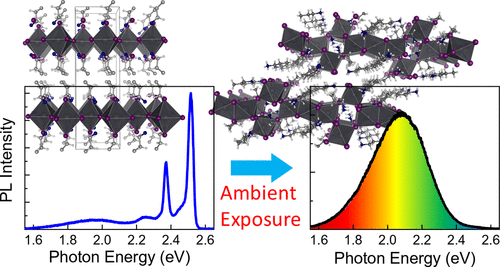当前位置:
X-MOL 学术
›
ACS Appl. Mater. Interfaces
›
论文详情
Our official English website, www.x-mol.net, welcomes your
feedback! (Note: you will need to create a separate account there.)
Structure-Dependent Photoluminescence in Low-Dimensional Ethylammonium, Propylammonium, and Butylammonium Lead Iodide Perovskites.
ACS Applied Materials & Interfaces ( IF 8.3 ) Pub Date : 2020-01-13 , DOI: 10.1021/acsami.9b17881 Chang-Wei Lin,Fangzhou Liu,Ting-Yang Chen,Kuan-Hua Lee,Chung-Kai Chang,Yanling He,Tik Lun Leung,Alan Man Ching Ng,Chia-Hung Hsu,Jasminka Popović,Aleksandra Djurišić,Hyeyoung Ahn
ACS Applied Materials & Interfaces ( IF 8.3 ) Pub Date : 2020-01-13 , DOI: 10.1021/acsami.9b17881 Chang-Wei Lin,Fangzhou Liu,Ting-Yang Chen,Kuan-Hua Lee,Chung-Kai Chang,Yanling He,Tik Lun Leung,Alan Man Ching Ng,Chia-Hung Hsu,Jasminka Popović,Aleksandra Djurišić,Hyeyoung Ahn

|
Hybrid organic-inorganic perovskites have attracted great attention as the next generation materials for photovoltaic and light-emitting devices. However, their environment instability issue remains as the largest challenge for practical applications. Recently emerging two-dimensional (2D) perovskites with Ruddlesden-Popper structures are found to greatly improve the stability and aging problems. Furthermore, strong confinement of excitons in these natural quantum-well structures results in the distinct and narrow light emission in the visible spectral range, enabling the development of spectrally tunable light sources. Besides the strong quasi-monochromatic emission, some 2D perovskites composed of the specific organic cations and inorganic layer structures emit a pronounced broadband emission. Herein, we report the light-emitting properties and the degradation of low-dimensional perovskites consisting of the three shortest alkylammonium spacers, mono-ethylammonium (EA), n-propylammonium (PA), and n-butylammonium (BA). While (BA)2PbI4 is known to form well-oriented 2D thin films consisting of layers of corner-sharing PbI6 octahedra separated by a bilayer of BA cations, EA with shorter alkyl chains tends to form other types of lower-dimensional structures. Nevertheless, optical absorption edges of as-prepared fresh EAPbI3, (PA)2PbI4, and (BA)2PbI4 are obviously blue-shifted to 2.4-2.5 eV compared to their 3D counterpart, methylammonium lead iodide (MAPbI3) perovskite, and they all emit narrow excitonic photoluminescence. Furthermore, by carefully optimizing deposition conditions, we have achieved a predominantly 2D structure for (PA)2PbI4. However, unlike (BA)2PbI4, upon exposure to ambient environment, (PA)2PbI4 readily transforms to a different crystal structure, exhibiting a prominently broadband light from ∼500 to 800 nm and a gradual increase in intensity as structural transformation proceeds.
中文翻译:

低维乙铵,丙铵和丁铵碘化钙钛矿中结构依赖的光致发光。
杂化有机-无机钙钛矿作为光伏和发光器件的下一代材料已引起广泛关注。但是,它们的环境不稳定性问题仍然是实际应用中的最大挑战。发现最近出现的具有Ruddlesden-Popper结构的二维(2D)钙钛矿可大大改善稳定性和老化问题。此外,激子在这些自然量子阱结构中的强烈限制导致可见光谱范围内的光发射窄而窄,从而可以开发可光谱调谐的光源。除了强烈的准单色发射外,某些由特定有机阳离子和无机层结构组成的2D钙钛矿还发出明显的宽带发射。在此处,我们报告了由三个最短的烷基铵间隔基,单乙基铵(EA),正丙基铵(PA)和正丁基铵(BA)组成的低维钙钛矿的发光特性和降解情况。虽然已知(BA)2PbI4可以形成定向良好的2D薄膜,该薄膜由两层BA阳离子隔开的角共享PbI6八面体层组成,但具有较短烷基链的EA倾向于形成其他类型的低维结构。然而,与3D对应的甲基铵碘化铅碘化钙(MAPbI3)钙钛矿相比,制备的新鲜EAPbI3,(PA)2PbI4和(BA)2PbI4的光吸收边缘显然蓝移至2.4-2.5 eV。窄的激子光致发光。此外,通过仔细优化沉积条件,我们获得了(PA)2PbI4的2D结构。
更新日期:2020-01-14
中文翻译:

低维乙铵,丙铵和丁铵碘化钙钛矿中结构依赖的光致发光。
杂化有机-无机钙钛矿作为光伏和发光器件的下一代材料已引起广泛关注。但是,它们的环境不稳定性问题仍然是实际应用中的最大挑战。发现最近出现的具有Ruddlesden-Popper结构的二维(2D)钙钛矿可大大改善稳定性和老化问题。此外,激子在这些自然量子阱结构中的强烈限制导致可见光谱范围内的光发射窄而窄,从而可以开发可光谱调谐的光源。除了强烈的准单色发射外,某些由特定有机阳离子和无机层结构组成的2D钙钛矿还发出明显的宽带发射。在此处,我们报告了由三个最短的烷基铵间隔基,单乙基铵(EA),正丙基铵(PA)和正丁基铵(BA)组成的低维钙钛矿的发光特性和降解情况。虽然已知(BA)2PbI4可以形成定向良好的2D薄膜,该薄膜由两层BA阳离子隔开的角共享PbI6八面体层组成,但具有较短烷基链的EA倾向于形成其他类型的低维结构。然而,与3D对应的甲基铵碘化铅碘化钙(MAPbI3)钙钛矿相比,制备的新鲜EAPbI3,(PA)2PbI4和(BA)2PbI4的光吸收边缘显然蓝移至2.4-2.5 eV。窄的激子光致发光。此外,通过仔细优化沉积条件,我们获得了(PA)2PbI4的2D结构。





















































 京公网安备 11010802027423号
京公网安备 11010802027423号